The Gavutu Tanambogo Campaign Game: SAND & BLOOD. An A.A.R.
"Commanders! Here is the plan for the invasion of Gavutu and Tanambogo.
[Comments]
Please consider this operation as a real operation at all effects. The japanese troops manning the installations will put up a fight, even if inferior in numbers and firepower. Some japs are manning machineguns on Gaomi and are
going to interfere.
Tomorrow at H+4 the 'chuters will land on Tanambogo from north, on twelve LCV.
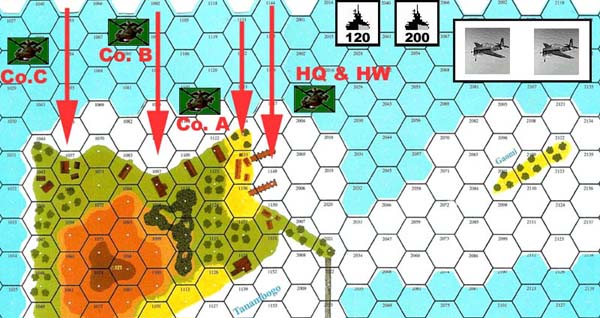
Mc Kennans' company A will land on the beach 1135, taking advantage of the cover offered by palm trees on east Tanambogo and the huts around the beach, using the wooden piers 1148 and 1149 to speed up the unloading of troopers and weapons.
Company B of captain Dick Johnson will descend in water on the North side
of Tanambogo, climbing on the the beachless north side of Tanambogo, in the houses from 1122 to 1083.
Company C is going land west of company B, to take point 1044.
Heavy weapons and battalion HQ as second wave will follow on the piers.
Air support is scheduled to cover your heads while you close to the beach and 20 minutes later.
The navy is going to make its part. Cruiser San Juan and destroyer Buchanan are going to shell Gaomi and Tanambogo to cover the first landings.
Destroyer Monsson is scheduled to remain on battle station during the first night, to shell in the dark any remaining enemy firebase harrassing our troops.
Expect an immediate reaction from the enemies that'll survive the first day. The first night is going to be restless, stragglers and pocket of resistance will choose the following night for aggressions against unguarding troops - prepare for some serious night clash at platoon level in this second period."
I
and Sergio decided to try seaborne invasions and play for a little more
than a single scenario. So, my plan to invade the two islands objective of the minicampaign published in Annual 93b is based on speed and massed support firepower to have the paramarines survive the landing. The troopers attack on unarmored landing crafts against fresh defences, so to help them I assign two NOBA batteries and two FB flight to this
period.
I plan to use the second period for the mandatory "night" battle, to hold a perimeter and bring in reinforcements with cover of dark. Then crush the defenders' strongpoints and clear them with the last two periods, using large firepower superiority.
Attacking the smallest island from N takes advantage of the coverage from fire caming from Gavutu offered by palms and jungle on Tanambogo, and with less space to front, the paramarines numbers will be packed - less space to enemy infiltration, better fire concentration. We will offer a better target and fire from Gaomi will be more punishing, anyway.
Troop distribution - roughly - west to east.
| Half Squad | 60mm LMT | Squad | Crew | LMG | DC | Leader | Unit |
| 2 | 1 | 1 | 8 -0 | Co.C | |||
| 2 | 1 | 1 | 1 | 8 -1 | Co.C | ||
| 2 | 1 | 9 -2 | Co.B | ||||
| 2 | 1 | 2 | Co.B | ||||
| 2 | 2 | 8-0 | Co.B | ||||
| 2 | 1 | 1 | Co.A | ||||
| 2 | 1 | 1 | 9 -1 | Co.A | |||
| 1 | 2 | 1 | 1 | 8-0 | Co.A | ||
| 1 | 2 | 1 | 1 | Co.A | |||
| 1 | 2 | 10 -2 | HQ | ||||
| 1 | 2 | 1 | 2 | 2 | 9 -1 | HW | |
| 1 | 2 | 1 | 2 | HW |
1000 yards... The battalion approches the objective on roaring landing crafts divided in four groups struggling to keep coesion but making a good formation show altogether.
600 yards... Somebody pretends to have seen aircrafts in the sky.
500 yards... The tops of the trees on Tanambogo move slowly under a weak breath of wind.
400... Brraaa-tttaBraaattt-Bratttta-tta-ttta-ta-ta-Brattt! A trail of shots splashing in the water rakes the formation from east! Bursts of 12,7 bullets tear pieces from boats. Frantic calls jam the radio. The battalion commander
10-2 has chosen to stay on the extreme left, and from Gaomi a section of AA automatic guns hits his LCV first. The half inch slugs pierce the landing crafts, men and weapons alike.
300... The 10-2's craft starts smoking and stops in water. From the top of Tanambogo hill
a 12,7 opens up with other guns from a machinegun nest, raking a LCV, some marine tries to escape death jumping overboard.
200... The boats are pushing engines to the limit. The leathernecks grasp their weapons. Personnel is seen moving amongst the houses on the shore. Machinegun fire erupts from foxholes behind the beach, plunging in the LCV heading for the sandline. "Japs infantry on the beach!" Another LCV is damaged by fire from the hill, the houses on the shore appear to be full of imperial infantry. Some marines shoot mounted fire from the LCV in desperation to cover the friends jumping off the boats to the shore. My men climbs up to the houses, while the first men of Company A run on the beach, jump on the pier. Marines enter in advance uphill in several building locations on the north side of Tanambogo occupied by japanese concealed squads,
we are CX but with clear firepower
advantage. In the ambushes two jap squads are hooked, the rest prefers to retreat and the most of japanese abandons the shoreline houses, retreating towards the jungle of center Tanambogo. Fire rains from the machinegun nest
( .50+HMG+10-2 leader) on the top pf Tanambogo hill killing more marines in the second wave crafts, while Gaomi battery claims little more damage. Commander
10-2 and the surviving marines abandon the LCV dead in water and swim towards the island.
Altogether prep fire of Jap turn 1 makes less damage I
feared.
My supporting fire hits hard. Navy batteries bombard Gaomi, killing three crews of the four present. Fighter bombers dive in effectively on hill 121, strafing a retreating squad beyond the jungle,
and the foxholes on the beach killing manning troops. A well aimed bomb eradicates the machinegun nest on the top of the hill blowing an high fountain of dirt for the cheering
paramarines (hit with a FB bomb, a "3" on
the resolution).
The troops recovers from the first fit of the operation, the shoreline is taken - at a cost in leaders:
I've lost a 9-2, a 9-1, a 8-1. The japanese ducks from the houses toward the jungle, to form a line of defence at the feet of the hill, but the fire from the shoreline houses, full with marines with LMG, erodes the jap plan. Company C takes control of the huts on point 1044, runs after their garrison and dispatches two jap squads losing a crew in CC. Fire rains down from a MMG in bunker on hill top. "There are enemies in caves on the side of the hill!" Company B in the center rallies in the houses and send a platoon in the jungle to discover the enemy defence line. On its left, company A pushes out of the small beach while the heavy weapons unloads. Beyond the beach the enemy has strewn foxholes, a bunker looking on the piers - the firepower of the japanese troops in not enough to keep back the leathernecks even if naval artillery stops firing for communication troubles.
Two queen of hearts. Heavy fire is exchanged from the japanese positions and the marines, several
U.S. squads break. Light mortars are assembled and start bombarding Gaomi where a last AA gun is still operative. Japan infantry staging behind the jungle is discovered by air observation and mercilessly strafed, a squad in a foxhole survives an attack with demo charges to be eliminated by sniper fire. With a strong push my boys exit the beach and invades the positions behind the beach. The bunker looking on the piers is eliminated in CC, while the platoon of company B occupies a trench in the jungle: the japanese defence line is broken. Imperial infantry retreats toward the hill.
Fire from Gaomi causes more losses. Being the intense mortar's fire uneffective, a massive air strike from a whole flight is called and obliterates all japanese troops from the diminutive island. A troop on a LCV is sent to take control of it.
The last japanese squads in the house behind the beach are unsupported, the area has been strafed, hit with mortars. The last crew tries to escape along the south beach with a wounded leader and a
malfunctioned MMG; they are chased by marines and all shot dead on their steps in the sand. I control all
N and W Tanambogo, from the jungle to the sea. Naval artillery falls and the top of the hill
erupts under the salvos. The marines take a breath while the
survivors of the immobilized LCV emerges from under a pier - unarmed, naked, but alive. The
10-2 commander takes charge of operation and heads for the jungle, where the platoons of Company A are explorating the bushy feet of hill Tanambogo. Other two caves have been discovered and sparse fire excanged with their occupants. The light mortars are brung on, in the foxholes amongst the palms, after trowing out the shattered remains of their fanatic defenders.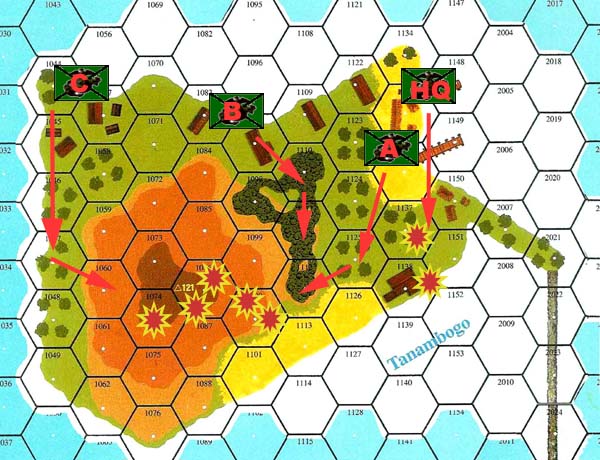
The navy erases the foxholes and all japs from the top, 200mm and 120mm grenades fall close to the bunker on the summit,
U.S. scouts have discovered a path free of enemy fire, up to the top.
Company B eventually silence the occupants of the first cave, looking north from the hill. A demolition charge destroys the enemy post, but the marines placing it reports that it seemed existing a complex of tunnel leading from the cave deep in the hill. In the same moment two squad, a crew - and the unarmed squad survived at the LCV - assault the bunker on the top of the hill and find inside a broken crew, that is killed promptly. An MMG is captured, weapons given to the unarmed marines; a tunnel going underground is found in the bunker too. "The defence was better prepared than believed." While the demolition charges are brung on and attack approaches studied, a small party of marines is sent on the causeway to scout Gavutu. Halfaway, fire is opened from west Gavutu too and the marine patrol retreats. It'd been too beautiful if all the defenders'd have been on Tanambogo only.
The light mortars, with observer's help, start to throw grenades across the strait, on the other island. Lacking other heavy weapons, the japaneses' are pushed to firing position. The Navy is again called to pound the enemy.
The japanese squads on the point of Gavutu island adjoining the causeway
are heavily bombarded while the paramarine battalion clears the rest of
Tanambogo.
Positions
on Tanambogo at the end of Turn 6
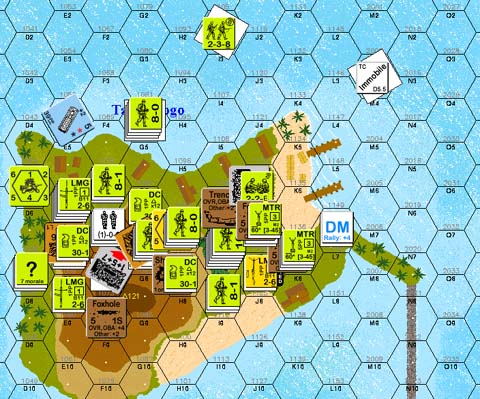
"Who
is in command here? I want a detachment from your platoon on the point of
the other island!"
"Yesser!"
Whole
situation (American point of view)
at the start of Turn 7
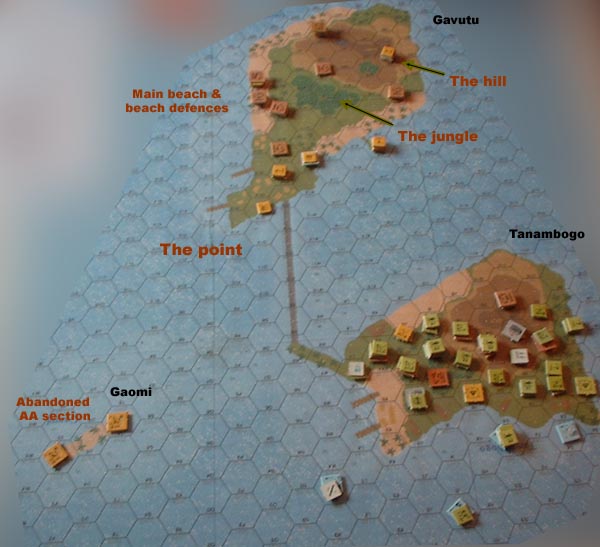
The half squad of marines is rallied and sent again across the causeway;
in the meanwhile the halfsquad on LCV going to Gaomi is detoured toward
"the point". The naval artillery stops firing (all
potential targets are concealed or out-of-LOS), anyway effective
mortar fire (two CH in a row) brushes the
japanese out of the closest huts and houses on Gavutu. The handful of marines runs
throught the whole lenght of the causeway and a japanese squad emerges
from concealment to bear to firing position a LMG, but the weapon fails to
shoot (BX)! Unharmed by enemy fire the lucky marines jumps into the first huts of
Gavutu. Minutes later the LCV unloads the second detachment on Gavutu. The
first one starts scouting the huts and palms patches on "the
point" and their luck runs out: they discover a bunker onlooking the sea E, but suffer losses
(casualties on a search).
Only five marines stay on Gavutu when sunset falls, combat on
Tanambogo still rages and the battle isn't going to quell for night.
In details, the Americans control all of
Tanabogo's surface where the Japanese is holed in two caves, in front of
each a platoon of paramarines pours heavy automatic fire with LMGs. On
Gavutu the Japanese main body stays motionless, in concealment, waiting
for the night. Until the end of the period very little happens. The
imperial infantry in the caves of Tanambogo is slowly attrited, no
movement on Gavutu's point also. I'm too weak to go anyware inland, Sergio
knows that any troop moving against the Marine's forward post would be
targeted by the supporting fire of the naval batteries, of the 60mm mortar
platoon, and of the whole paramarines battalion - there are only 7 hexes
between the two islands and the platoons on S Tanambogo can fire at long
rang on N Gavutu. Before the end of the period the only incident happens
when platoon of marines is broken by return fire from a cave, while some
marines rout away the japanese squad jumps out of its cave and engages in
close combat the survivors. Everybody is
killed in the melee.
"How
is going, boys?"
"A good fight, sir!"
"Let's go on the other i'land, sir!"
"Yeah!"
"Good boys. Sarge, have your men have some food and rest. The
enemy is putting up a stiff resistance and the night is going to be
sleepless."
"Yesser!"
In the ailing light resounds the noise of blasts of rifle fire,
similar to firing range echoes. In front of two caves platoons of marines
wait for the appearance of any movement in the hillside caves to fire a
rain of bullets. Two demolition charges are unsuccesfully dropped in the
caves from above.
Ammunitions are unloaded on the beach, weapons are maintaned, the wounded evacuated,
reinforcements called.
For
the second period, played in night condition, I assign a third naval
battery for off board support, and schedule the arrival of two
reinforcement groups: company "I" and company "K" of 3rd Battalion, 2nd Marine
regiment. I choose these formations because they have the most support
weapons. My plan is to dig foxholes on Tanambogo hill while the
reinforcements land. The marines, with a MMG, go to Gavutu, landing on the
"point", while the heavy weapons - 3 HMG (two are .50 calibres),
2 60mm mortars - are put in firing position on Tanambogo. After finishing
off the defenders in Tanambogo, I'll move the infantry mass from it to
Gavutu with the cover of darkness; the objective is taking "the
point" and the area behind it during the night period as a base for clearing Gavutu in the
two following periods.
I struggled for having a MMC on Gavutu, even if a single HS, because the
presence of my troops denies to Sergio the opportunity of rearrange his
troops on Gavutu.
At the start of the second period, the Japanese on Gavutu are set up in single hex stacks around "the jungle" of Gavutu, two stacks are on Gavutu hill and a cluster of foxholes in palm hexes stays guarding the E beach, the biggest landing place. Fighting at night, I expect a lot of hidden unit jumping out of nowhere.
Positions
at the start of turn1, second period
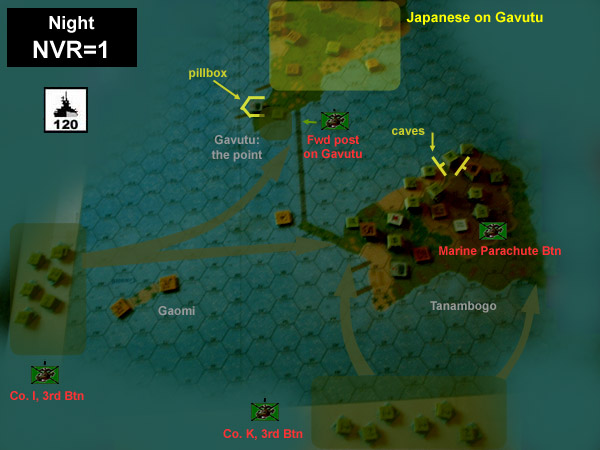
The
small patrol of marines waits on Gavutu with the wounded, in the falling
shadows of the evening the shape of the hill of Gavutu appears hiding
unspeakable threats. The Japanese have left small traces of their
presence: an abandoned foxhole, stains of blood. The pillbox on the beach,
from which shots have been fired that killed three men in the afternoon
scouting, is silent. Nothing moves for a long time. The night covers
the sea; the sky is cloudy and moon obscured. Combat goes on on Tanambogo.
At a moment a clash erupts on the hillside: a sharp burst of multiple
firearms. Then, silence. The young soldiers on Gavutu stare on the other
direction for sneaking enemies. Nothing.
An hour later the night resounds on engines, a few minutes and landing
crafts close to the point, careful to avoid the field of fire of the
bunker in the thick darkness.
Positions
on Gavutu at the start of second period (hidden units visible)
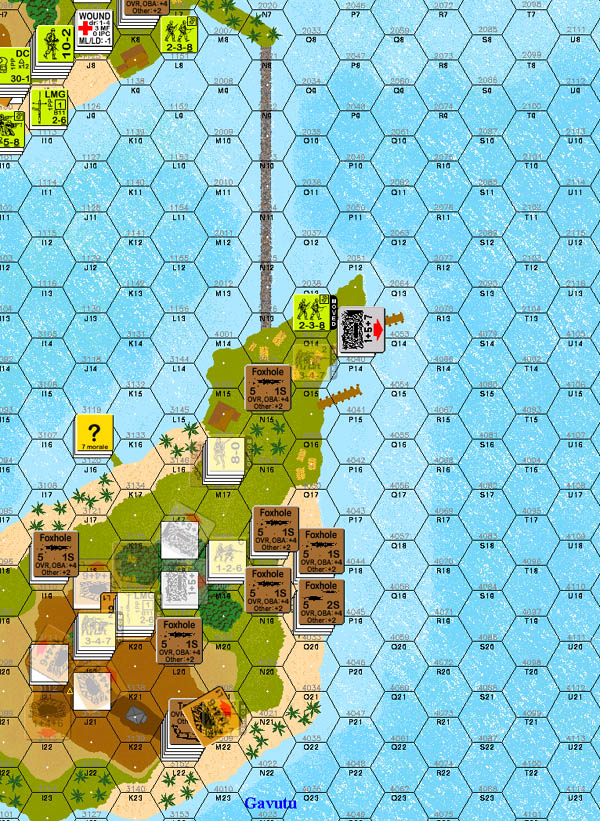
The NVR dropped to "1" while the landing crafts arrived. This make my work easier. For the first turns the fight is only on Tanambogo, where all the defenders are killed by multiple "36+" attacks.
Sweating marines dig foxholes on Tanambogo hill and the heavy weapons are sent uphill from the beach. Sniper activity in E Tanambogo around the mortar battery is contained with a belt of young soldiers. Only on the following morning Tanambogo will be declared "secure". On Gavutu the first platoons spread throught the "point". In the very first huts further S an hidden enemy squad is discovered by scouting and targeted with small arms fire.
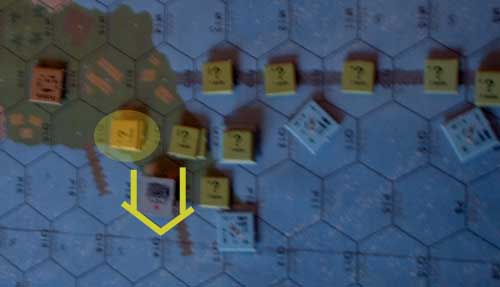
The Americans command pushes S to get space to deploy over all of the incoming troops. Platoons are arranged to drive toward the area behind "the point" and one is assigned to the destruction of the pillbox in front of the piers. This mission is accomplished easily, the main force moves shooting in the night to flush enemies out of hideouts, buildings are scouted on the move. The enemy squad retreats in good order with losses. The advance guard tries to stay close at them and runs in troubles. Just beyond the scouted area an enemy platoon appears out of a trench and the "pursued" enemy turns back and fires.
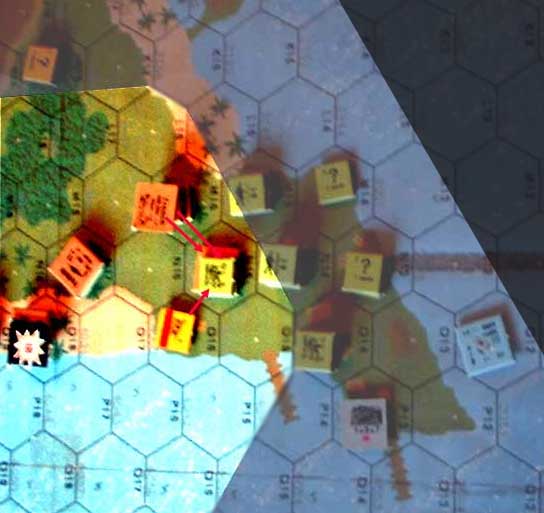
Even
if illuminating rounds are shot to clear the fields of fire, the advancing
squads are broken by concentrated fire. The soldiers try to surrender and
are all shot dead with raised hands (two squads
eliminated by massacre). News of the japanese massacre quickly
spread: the battle for Gavutu has started in earnest and in hate.
On "the point" marines assemble an MMG and all platoons exchange fire
with the closest enemy position. The
Marines six light mortars start to launch illuminating round on Gavutu.
All the platoons advance laying a screen of fire on their front, on all
targets. A japanese soldier jumps out of the trench
holding a demolition charge and automatic fire tears him in pieces; the
battle with the rest of the japanese platoon breaks several U.S. squads that
retreat behind the line of the other leathernecks; after minutes of fire
the japanese leader gets killed and his soldiers are overwhelmed. On the
seaside the japanese foxholes are targeted with heavy rifle fire and a
mission of the naval artillery is cleared for fire for effect on them. The
marines push on all line and the japanese resistance in front of "the
jungle" crumbles.
Other illuminating ammunition hung over in the sky and the Americans
advance a platoon in the empty area to the limit of the dark jungled area
in the center of Gavutu. Another pillbox opens up uneffectively and its
occupants are counterattacked by heavy fire.
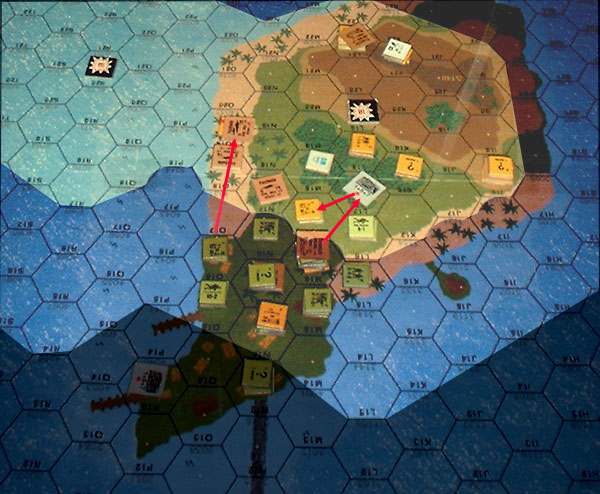
On the front of "the jungle" enemy firepower is weak and the marines advance confidently on its flanks, clearing the beaches and grasping the feet of Gavutu hill. All the Japanese appearing are attacked with intense fire. From Tanambogo hill, completely controlled by the U.S., the heavy machineguns pours deadly fire (19 FP with 8-1 leader) on all Japanese in the open.
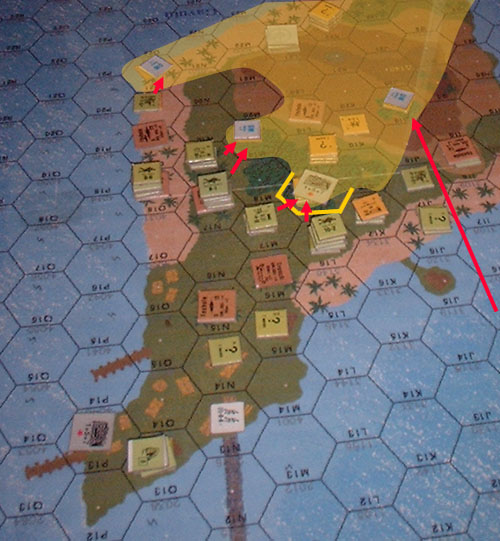
The pillbox is
attacked with grenades and occupied. The sky is completely covered with
clouds (NVR drops to "0"). From a
cave shots are fired against the flanking scouts. American machine gun bursts jump
across the water and plunge in the black hole in the hill side.
"Commander, we have platoons on both sides of the hill and in the
jungle."
"Take positions and reorganize your men, captain. We will clear the
jungle tomorrow morning."
I'm satisfied with my progress at night. The Japanese player retreated behind "the jungle" and Gavutu hill. Clearing the jungle would require from me attacking hidden Japanese at night, risking deadly ambushes. The same, climbing on the sides of the hill will bring in cave combat. I prefer to wait the following periods for clearing Gavutu.
In the third period I spend all my reinforcements. I do not think that any japanese soldier will stay above ground until the fourth. I use two more FB flights and the last naval battery, 200 mm.
Start
of third period, view from japanese side
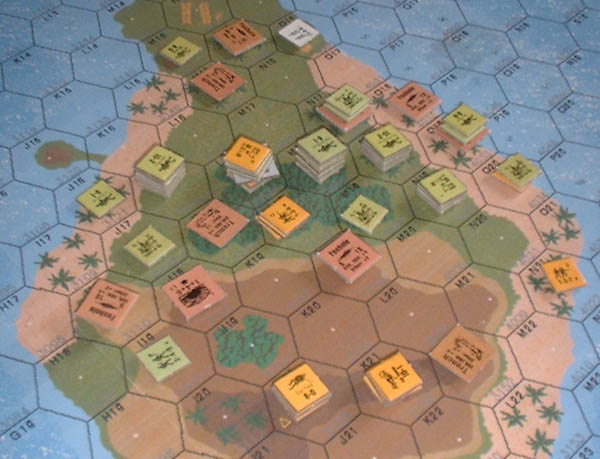
The
marines' commander is looking with binoculars, far in the sea, the
progress of incoming reinforcements, another company and a pair of light
tanks, when the battle erupts on Gavutu. Long burst of machinegun dominate
the sky, japanese machineguns.
"Captain! Report!"
"The enemy has set a machinegun nest in the brick building on the top
of the hill and is throwing down a rain of lead!"
The area of "the jungle" is full of marines opening fire,
calling for medic or helping wounded comrades. Naval artillery is called to
suppress the enemy position, the 60mm battery from Tanambogo throws
grenades against the building. The japanese leader and crews, undaunted,
keep discharging deadly fire on the leathernecks. Air attacks fail to
identify the target and a bomb mistakenly falls in the jungle, disrupting
a whole platoon; a marine major is seen stumbling in tears out of the
green, taken by hand by a junior officer (disrupted
10-2). Bold marines try to climb
closer to the enemy position. More Japanese open fire from a cave and push
them back. Other air strikes are unsuccesful, repeated strafing has no effect.
On the radio the naval artillery fails to clear for a mission. The
situation downhill is heavy, more than thirty marines have been killed
outright. The 60mm grenades rain on the target only to have more
machinegun bursts fall down on the marines.
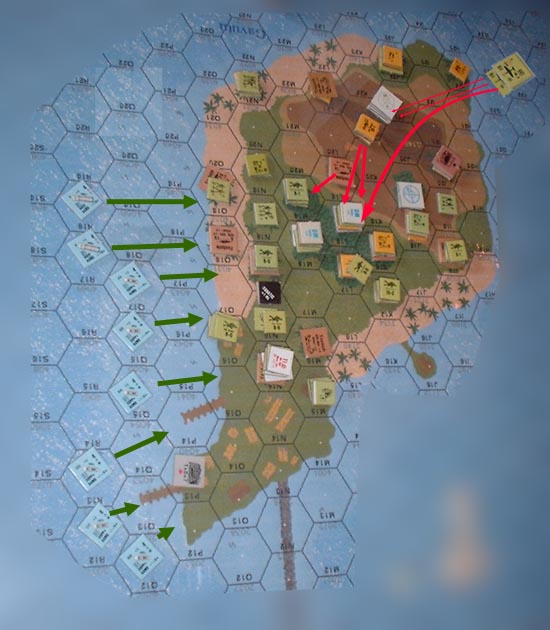
Eventually,
cruiser artillery pounds the hillttop. The marines are reorganized and
attack the lower caves, two of them are sealed with demolition charges.
When the dust settles on the hilltop, the machinegun nest is still active
and takes out other Americans. Intense automatic fire from the jungle is
aimed uphill, more mortar fire falls down on the building. After hundreds
of mortar round, some explodes inside (CH): the machineguns stop firing. A
marine captain leads
two platoon in an advance toward the top. After them, in a single big
leap, a composed marine company occupies Gavutu hill and the imperial
soldiers retreating from the top are strafed by fighter bombers. First,
they duck, then the pilot reports seeing some soldier charging back toward
the hill. In the moment they reach the top the marines face a mad charge
from an handful of frenzied enemies (japanese leader
turns berserk two crews). The japanese charging uphill in the open are
all but killed by brutal fusillade. Gavutu hill is taken.
In the following hour more caves are discovered on its sides and are all
sealed with democharges. Single heavy loss, an american light tank gets destroyed by
enemies that sneaked out of a cave on the unscorted vehicle to be then decimated with
small arms fire.
There is little to say about the third period. The machineguns on the top of Gavutu rated several times and survived heavy shelling. In three turns I lost 7 squads to the 10-1 jap leader and mistaken air attack but when my last reinforcement arrived I had so much soldiers that I experienced severe problems in avoiding overstacking. My superiority in firepower at that point was absolute and with neutral dice the japanese troops were helpless. I cleared all Gavutu before the end of the third period.
My comment about this minicampaign is that the Japanese player has no manouver space, besides movement through caves, complexes and tunnels and unless particularly fond of "dirty tricks" he could find this situation boring. For the american it is a wonderful training range for seaborne invasions and cave combat; he has only to spare the democharges for cave sealing, I almost runned out of them.
Next dish on the menu: Tarawa.
Japanese player: sergio64 - American player: oxpinguin